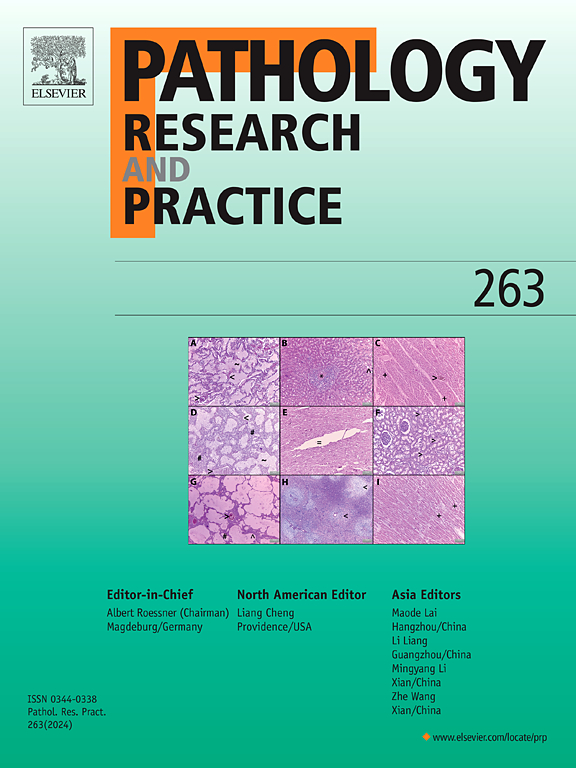MicroRNAs and long non-coding RNAs In T-cell lymphoma: Mechanisms, pathway, therapeutic opportunities
IF 2.9
4区 医学
Q2 PATHOLOGY
引用次数: 0
Abstract
T-cell lymphomas represent non-Hodgkin lymphomas distinguished by the uncontrolled proliferation of malignant T lymphocytes. Classifying these neoplasms and the ongoing investigation of their underlying biological mechanisms remains challenging. Significant subtypes encompass peripheral T-cell lymphomas, anaplastic large-cell lymphomas, cutaneous T-cell lymphomas, and adult T-cell leukemia/lymphoma. A systematic literature survey used electronic databases, including PubMed, Springer Link, Google Scholar, and Web of Science. Search keywords included "T-cell lymphoma," "therapeutic approaches," "RNA therapeutics," "microRNA," and "signaling pathways". T-cell lymphomas are believed to arise from a complex interplay of genetic predispositions and environmental factors. Epstein-Barr virus (EBV) and Human T-cell leukemia virus-1 (HTLV-1), have been implicated as potential etiologic agents. While the exact molecular mechanisms are under investigation, T-cell lymphomas are distinguished by aberrant proliferation of T-cells resulting from dysregulated gene expression. Contemporary research has emphasized the significance of non-coding RNAs, including microRNAs and long non-coding RNAs, in the etiology and advancement of T-cell lymphomas. Certain miRNAs function as tumor suppressors (e.g., miR-451, miR-31, miR-150, miR-29a), while others can act as oncogenes (e.g., miR-223, miR-17–92, miR-155). Additionally, lcRNAs are responsible for modulating gene expression, and their influence on T-cell function suggests their potential outcome as therapeutic targets.
Current therapeutic strategies for T-cell lymphomas predominantly rely on chemotherapy, with emerging modalities encompassing immunotherapy and targeted therapies. Despite these advancements, a substantial subset of T-cell lymphomas remains challenging to manage, especially those in advanced stages or refractory to conventional treatments. RNA-based therapeutics represent a promising strategy, offering many advantages such as targeted therapy, potential for personalized medicine, reduced side effects, rapid development, and synergy with other therapies while facing challenges in delivery, immune response, and specificity. Future research should focus on improving delivery systems, modulating immune responses, and optimizing production to unlock its full potential. This review comprehensively explored T-cell lymphomas, delving into their classification, pathogenesis, and existing therapeutic options. Additionally, we explore the evolving function of non-coding RNAs in the pathogenesis of T-cell lymphoma. Furthermore, we discuss the potential of RNA-based therapeutics as a promising treatment strategy.
t细胞淋巴瘤中的microrna和长链非编码rna:机制、途径和治疗机会。
T细胞淋巴瘤是非霍奇金淋巴瘤,以恶性T淋巴细胞不受控制的增殖为特征。分类这些肿瘤和正在进行的调查其潜在的生物学机制仍然具有挑战性。重要的亚型包括外周t细胞淋巴瘤、间变性大细胞淋巴瘤、皮肤t细胞淋巴瘤和成人t细胞白血病/淋巴瘤。系统的文献调查使用了PubMed、施普林格Link、谷歌Scholar和Web of Science等电子数据库。搜索关键词包括“t细胞淋巴瘤”、“治疗方法”、“RNA治疗方法”、“microRNA”和“信号通路”。t细胞淋巴瘤被认为是遗传易感性和环境因素复杂相互作用的结果。Epstein-Barr病毒(EBV)和人类t细胞白血病病毒-1 (HTLV-1)被认为是潜在的病原体。虽然确切的分子机制仍在研究中,但t细胞淋巴瘤的特点是基因表达失调导致t细胞异常增殖。当代研究强调了非编码rna,包括microRNAs和长链非编码rna在t细胞淋巴瘤的病因和进展中的重要性。某些mirna可作为肿瘤抑制因子(如miR-451、miR-31、miR-150、miR-29a),而其他mirna可作为致癌基因(如miR-223、miR-17-92、miR-155)。此外,lcRNAs负责调节基因表达,它们对t细胞功能的影响表明它们作为治疗靶点的潜在结果。目前t细胞淋巴瘤的治疗策略主要依赖于化疗,新兴的治疗方式包括免疫治疗和靶向治疗。尽管取得了这些进展,但相当一部分t细胞淋巴瘤的治疗仍然具有挑战性,特别是那些处于晚期或对常规治疗难治的t细胞淋巴瘤。基于rna的治疗方法是一种很有前途的治疗策略,它具有许多优点,如靶向治疗、个性化治疗的潜力、副作用小、发展快、与其他治疗方法协同,但在递送、免疫反应和特异性方面面临挑战。未来的研究应侧重于改善输送系统、调节免疫反应和优化生产,以充分发挥其潜力。本文全面探讨了t细胞淋巴瘤的分类、发病机制和现有的治疗方案。此外,我们还探讨了非编码rna在t细胞淋巴瘤发病机制中的进化功能。此外,我们讨论了基于rna的治疗方法作为一种有前途的治疗策略的潜力。
本文章由计算机程序翻译,如有差异,请以英文原文为准。
求助全文
约1分钟内获得全文
求助全文
来源期刊
CiteScore
5.00
自引率
3.60%
发文量
405
审稿时长
24 days
期刊介绍:
Pathology, Research and Practice provides accessible coverage of the most recent developments across the entire field of pathology: Reviews focus on recent progress in pathology, while Comments look at interesting current problems and at hypotheses for future developments in pathology. Original Papers present novel findings on all aspects of general, anatomic and molecular pathology. Rapid Communications inform readers on preliminary findings that may be relevant for further studies and need to be communicated quickly. Teaching Cases look at new aspects or special diagnostic problems of diseases and at case reports relevant for the pathologist''s practice.

 求助内容:
求助内容: 应助结果提醒方式:
应助结果提醒方式:


